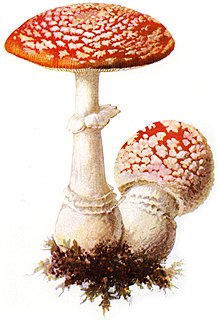
The genus Amanita contains about 600 species of agarics, including some of the most toxic known mushrooms found worldwide, as well as some well-regarded edible species. This genus is responsible for approximately 95% of the fatalities resulting from mushroom poisoning, with the death cap accounting for about 50% on its own. The most potent toxin present in these mushrooms is α-amanitin.

The vermilion grisette, also known as pretty grisette or vermilion amanita is a colourful mushroom of the genus Amanita. However, although it is often referred to by the common name "grisette", it is not closely related to other edible species that carry this common name, such as Amanita vaginata and Amanita fulva. It belongs to the same group of Amanita as A. muscaria and is reported to be toxic.
Amanita altipes, also called the yellow long-stem amanita, is a species of agaric fungus found on soil in coniferous and broadleaved woodland in southwestern China up to an altitude of 4,000 metres (13,000 ft). The specific epithet altipes means "referring to the long stipe", and it suits the species as it has a longer stipe compared to its relatives.
Amanita parvipantherina, also known as the Asian small panther amanita, is a species of agaric restricted to Yunnan province in China. It is strongly associated with the Yunnan Pine Pinus yunnanensis. It fruits in July and August.
Amanita subjunquillea, also known as the East Asian death cap is a mushroom of the large genus Amanita, which occurs in East and Southeast Asia. Potentially deadly if ingested, it is closely related to the death cap A. phalloides.

Amanita vaginata, commonly known as the grisette, is an edible mushroom in the fungus family Amanitaceae. Unlike many other Amanita mushrooms, A. vaginata lacks a ring on the stem. The cap is gray or brownish, 5 to 10 centimetres in diameter, and has furrows around the edge that duplicate the gill pattern underneath. It has a widespread distribution in North America, and is thought to be part of a species complex that includes other similar-looking Amanitas.
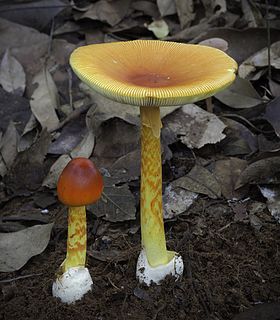
Amanita hemibapha, commonly known as the half-dyed slender Caesar, is a species of agaric found in southeast Asia and Oceania, although some distribution reports may refer to different taxa.

Amanita magnivelaris, commonly known as the great felt skirt destroying angel, is a highly toxic basidiomycete fungus, one of many in the genus Amanita. Originally described from Ithaca, New York, by Charles Horton Peck, it is found in New York state and southeastern Canada.
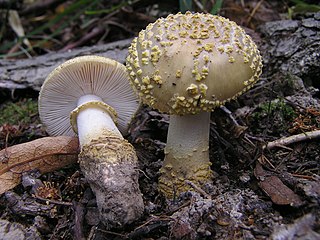
Amanita franchetii is a species of fungus in the family Amanitaceae. It was given its current name by Swiss mycologist Victor Fayod in 1889 in honor of French botanist Adrien René Franchet. A. franchetii occurs in Europe and North Africa with oaks, chestnuts, and pines.

Amanita pekeoides is a species of fungus in the family Amanitaceae. It was first described scientifically by New Zealand mycologist Geoff Ridley in 1991.
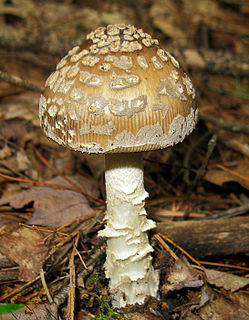
Amanita ceciliae, commonly called snakeskin grisette and strangulated amanita, is a basidiomycete fungus in the genus Amanita. First described in 1854 by Miles Joseph Berkeley and Christopher Edmund Broome, it was given its current name by Cornelis Bas in 1984. It is characterized by bearing a large fruit body with a brown cap 5–12 cm (2.0–4.7 in) across. The cap has charcoal-grey patches, which are easily removable. The stipe is 7–18 cm (2.8–7.1 in) long, white in colour, and there is no ring on it. It is slightly tapered to the top, and has irregular cottony bands girdling the base. The universal veil is grey. Spores are white, spherical in shape, non-amyloid, and measure 10.2–11.7 micrometres. The mushrooms are considered edible, but field guides typically advise caution in selecting them for consumption, due to risks of confusion with similar toxic species. A. ceciliae is found in woods throughout Europe and North America, where it fruits during summer and autumn.
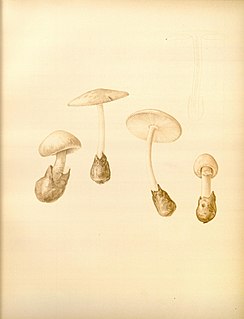
Amanita volvata, also known as volvate amanita is an inedible white-coloured species of fungi from the family Amanitaceae found in the southeastern United States. Can be confused with Amanita ponderosa, but that species is from the Iberian peninsula. The species is amyloid and have saccate volva, and elliptic spores.

Amanita fuliginea, commonly known as the east Asian brown death cap, is a species of deadly poisonous mushroom in the family Amanitaceae. It was described as new to science by Japanese mycologist Tsuguo Hongo in 1953. Fruit bodies have convex, dark gray to blackish caps measuring 3–6 cm (1.2–2.4 in) in diameter. The gills, largely free from attachment to the stipe, are white and have short gills (lamellulae) interspersed. The spores are roughly spherical, amyloid, and typically measure 8–11 by 7–9.5 µm. The mushroom is common in China, where it has caused poisonings, a review of cases in southern China finding it had been responsible for the poisoning of 352 people, 79 of which died, between 1994 and 2012.

Amanita excelsa is a species of agaric fungus in the family Amanitaceae. It is found in Asia, Europe, and North America, where it grows in deciduous forests.
Amanita pallidorosea is a mushroom of the large genus Amanita, which occurs under beech and pine in China and Japan. It is closely related to the destroying angel A. bisporiga.
Amanita subpallidorosea is a mushroom of the large genus Amanita, which occurs under oaks in southern China and Taiwan. It is closely related to the destroying angel mushrooms A. virosa and A. ocreata.
Amanita griseorosea is a mushroom of the large genus Amanita, which occurs under beech in southern China. It is closely related to A. molliuscula.
Amanita molliuscula is a mushroom of the large genus Amanita, which occurs under beech in Shaanxi Province in China. It is closely related to A. griseorosea.
Amanita parviexitialis is a mushroom of the large genus Amanita, which occurs under beech in southern China.










